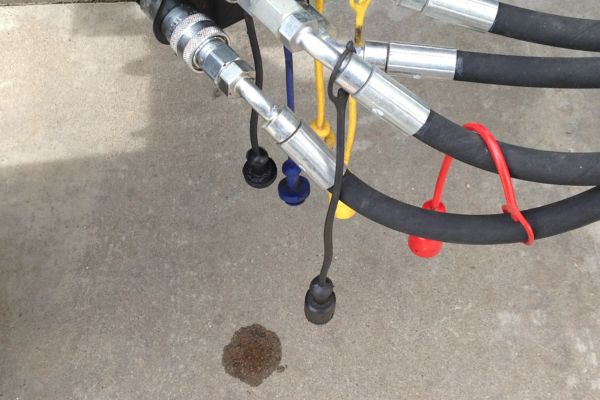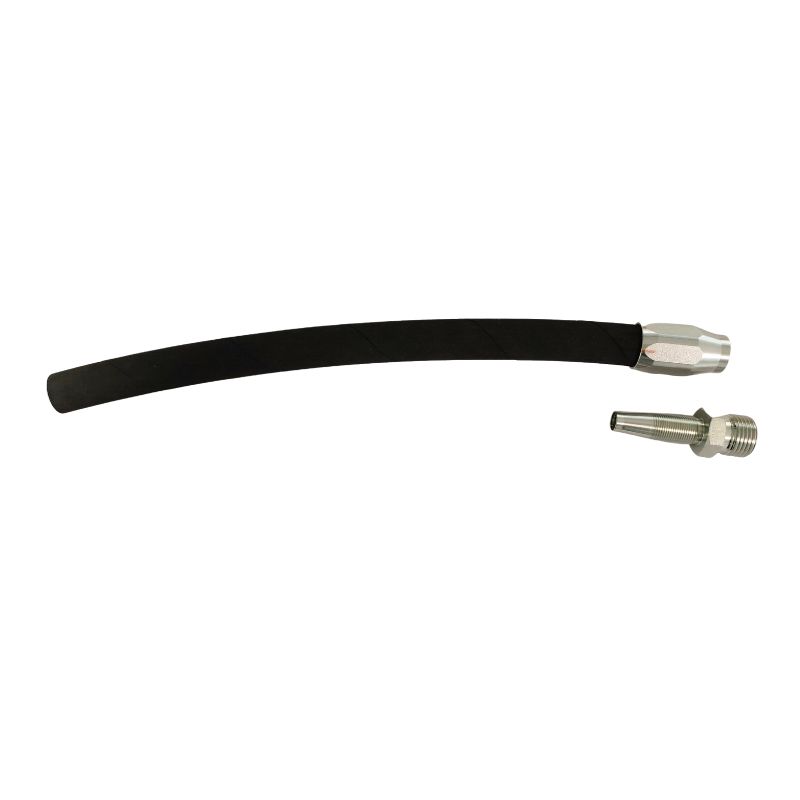A hose blow-off is a catastrophic event, not a simple leak. This guide dissects the critical, often-overlooked root causes—from flawed crimping and mismatched parts to installation errors—to give you the expert knowledge needed to prevent them.
Anatomy of a Catastrophe: What is a Blow-Off?
A hose blow-off is the complete and sudden separation of the hose from its crimped fitting. It is one of the most dangerous failures in a hydraulic system, releasing a large volume of high-pressure fluid in an instant.

Blow-Off vs. Leak: A Critical Distinction
Not all failures are created equal. A leak is a warning; a blow-off is a violent mechanical failure. Understanding the difference between the two is essential for both safety and diagnostics.
A leak happens when the sealing interface — such as an O-ring, flare, or tube connection — is compromised. Fluid seeps through small gaps under pressure, often starting as a slow drip or mist.
A blow-off, however, is catastrophic. It occurs when the fitting loses its mechanical grip on the hose entirely. The hose separates from the fitting with explosive force, releasing high-pressure fluid and converting the hose into a whipping projectile.
The Unseen Forces at Play
Inside every working hydraulic hose lies stored energy equal to tons of force. To illustrate:
A 1-inch diameter hose operating at 4,000 PSI is resisting over 3,100 pounds (1.4 metric tons) of pressure trying to eject the fitting. The crimped connection is the only barrier keeping that energy contained.
If the crimp is under-sized, over-sized, or uneven, or if the hose was not fully inserted, the fitting’s teeth fail to grip the wire reinforcement layer — and the entire system loses containment in an instant.
| Cause | Description |
| Under-Crimp | Hose not fully compressed; loose grip on wire braid |
| Over-Crimp | Reinforcement crushed; internal damage and cracks |
| Wrong Hose Type | Mismatch in construction or diameter tolerance |
| Poor Insertion | Hose not seated to full depth before crimping |
| Twisted Hose | Rotational stress loosens grip during operation |
The Danger Is Immediate and Severe
A blow-off is not just a maintenance failure — it’s a safety emergency. The combination of high pressure, velocity, and mass creates lethal conditions.
- Fluid injection injuries: High-pressure oil can pierce the skin like a needle, causing tissue death and requiring immediate surgery.
- Whipping hazard: A detached hose end can move faster than 100 mph, striking with enough force to fracture bones.
- Secondary damage: The sudden pressure drop can destroy pumps, valves, and actuators within seconds.
Safety Reminder: Always depressurize the system before inspection. Never lean over pressurized hoses or fittings, even for a visual check.
Preventing Blow-Off Events
Blow-offs are 100% preventable when the correct assembly and inspection procedures are followed:
- Use matched systems — hose and fittings from the same manufacturer.
- Verify insertion depth before crimping using clear visual marks.
- Measure crimp diameter precisely with a digital caliper.
- Inspect for alignment and discard any angled or uneven crimps.
- Pressure-test every hose assembly before installation.
A hose assembly that passes visual and dimensional inspection is your best guarantee of safety. Never compromise on these steps — a single shortcut can have catastrophic consequences.
The Crimp Itself: An Analysis of Flawed Assembly
A hydraulic hose crimp is a precision-engineered joint—not just a compression of metal over rubber. It’s the mechanical bond that contains thousands of pounds of pressure inside the system. Yet, over 80% of blow-off incidents trace back to flaws made during the assembly stage.
The crimp must compress the fitting shell just enough to grip the hose’s reinforcement layer without crushing it. A deviation of even 0.1 mm can mean the difference between a perfect seal and a dangerous failure under pressure.

The #1 Cause: The Under-Crimp
The most frequent cause of hose separation is an under-crimp—when the crimp diameter is larger than specified.
In this case, the fitting shell fails to compress the reinforcement tightly enough, leaving microscopic gaps between the hose and shell. During operation, pressure pulsation and vibration cause micro-movements that gradually loosen the connection until it slips off entirely.
Symptoms and Risks:
- Fitting feels loose when handled
- Fluid weeping at the shell edge
- Sudden blow-off during pressure spikes
Prevention: Always verify the final crimp diameter using a calibrated digital caliper. Compare readings with the crimp chart and discard any assembly outside the tolerance range (typically ±0.005 inches or ±0.13 mm).
The Deceptive Threat: The Over-Crimp
An over-crimp occurs when the fitting is compressed too much, producing a smaller-than-specified crimp diameter.
Although it might look tight and secure, the excessive pressure crushes the wire reinforcement and can cut into the inner tube. The result is an internal weak point where the hose will eventually burst or crack near the fitting.
Symptoms and Risks:
- Distorted or flattened crimp appearance
- Cracking or swelling near the fitting after pressurization
- Reduced flexibility and premature hose rupture
Prevention: Always check the crimper’s calibration and die selection before each job. A slight setting error or wrong die number can lead to irreversible over-crimping.
The Hidden Flaw: Incorrect Insertion Depth
Even when the crimp diameter is perfect, a hose that wasn’t fully inserted into the shell is already compromised.
The internal teeth of the fitting are designed to grip the reinforcement layer, not the outer cover or the inner tube. If the hose is under-inserted, the crimp bites into the weaker rubber instead of the steel wire, leading to slippage or a full blow-off under load.
Symptoms and Risks:
- Fitting separates cleanly from hose under pressure
- Shiny or smooth rubber visible inside fitting after failure
- No visible mark alignment with fitting shell
Prevention: Always mark the insertion depth before crimping and confirm visually that the mark aligns flush with the back edge of the fitting shell.
The Mismatched System: A Guarantee of Failure
You cannot create a safe hose assembly by mixing and matching components from different manufacturers. Each brand engineers their hose and fittings to work as a “matched system” with unique tolerances. Deviating from this is a direct path to failure.
The Myth of “Interchangeability”
While a JIC fitting from one brand may thread into another, the critical dimensions of the hose and the crimp shell are not standardized. A thousandth of an inch difference in hose outer diameter can be the difference between a secure grip and a blow-off.
Hose Tolerances and Fitting Design
Manufacturers design their fitting shells and crimp specifications around the exact construction and tolerance of their own hose. Using another brand’s hose, which may be slightly smaller or larger, makes achieving the correct compression impossible.
The Skive vs. No-Skive Error
A common and critical error is failing to identify the hose type. Using a “No-Skive” fitting on a hose that requires the outer cover to be “skived” (removed) will result in a severely under-crimped connection that will almost certainly blow off.
| Component Selection | Correct “Matched System” Approach | Incorrect / Mismatched Approach | Likely Outcome of Mismatch |
| Hose & Fitting | Use a Brand A hose ONLY with a Brand A fitting designated for that specific hose series. | Using a Brand A hose with a Brand B fitting, even if they are the same size and pressure rating. | Blow-Off Risk. The crimp will be either too loose or too tight, leading to a weak grip or internal hose damage. |
| Crimper & Dies | Use the die set specified by the crimper manufacturer’s chart for the exact hose/fitting combo. | Guessing the die set based on size, or using a die from a different manufacturer’s crimper. | Blow-Off Risk. Crimp diameter will be incorrect. The crimp may also be misshapen, concentrating stress on the hose. |
| Hose Type | Correctly identifying the hose as “Skive” or “No-Skive” and following the proper procedure. | Skiving a No-Skive hose, or failing to skive a hose that requires it. | Blow-Off Risk. Skiving a No-Skive hose removes too much material, leading to a severe under-crimp and grip failure. |
| Pressure Rating | Selecting a hose and fitting combination with a Maximum Allowable Working Pressure (MAWP) equal to or greater than the system’s maximum pressure. | Using a 3000 PSI hose in a circuit that sees pressure spikes of 4500 PSI. | Burst or Blow-Off. The assembly is simply not strong enough to contain the system’s force. |
Installation Errors: Creating Stress on the Connection
A flawless crimped hose can still fail in the field if it’s installed under mechanical stress. Hydraulic hoses are flexible by design—but only within specific limits. When they are stretched, twisted, or bent beyond those limits, the forces transfer directly into the crimp, progressively loosening or damaging the fitting.
Correct routing and installation are just as critical as proper assembly. Every inch of hose must move naturally with the machine, not against it.

Axial Tension: The Straight Pull
A hose should always have a slight, relaxed curve—never be pulled tight.When installed too short, the hose remains under constant axial tension, like a cable being pulled from both ends. This tension tries to pull the fitting out of the crimp, especially under pressure cycles or machine motion.
Consequences:
- Gradual stretching of the reinforcement layer
- Separation at the fitting under load
- Early fatigue and internal delamination
Prevention Tips:
- Route hoses with 2–4% slack to accommodate pressure growth.
- Avoid direct, straight-line connections between moving parts.
- Use 90° or 45° fittings if needed to reduce tension.
Torsional Stress: The Deadly Twist
![Image: A side view of a hydraulic hose showing rotation arrows and internal braid distortion caused by twisting.]
Twisting is one of the most destructive installation errors. Hydraulic hoses are reinforced with steel wire braids wound in opposite directions. When twisted, these braids fight against each other, generating torsional stress that weakens the hose from the inside out.
Even a 5–10° twist can reduce service life by up to 90%.
Effects of Twisting:
- Internal wire distortion and strand breakage
- Hose trying to “unwind” under pressure, stressing the crimp
- Fitting rotation or back-out during operation
Prevention Tips:
- Never rotate the hose while tightening fittings.
- Align the hose by holding the fitting body, not the hose.
- Check for visual twist by marking a straight reference line along the hose before installation.
Violating the Minimum Bend Radius
Each hydraulic hose type has a minimum bend radius (MBR)—the tightest curve it can safely handle without damaging its structure.
When a hose is bent too sharply—especially near the fitting—the outer wire reinforcement is overstressed while the inner tube collapses, concentrating stress where the hose exits the crimp shell.
This leads to:
- Cracking or bursting near the fitting
- Flattened or kinked hose sections
- Reduced flow and heat buildup
Prevention Tips:
- Maintain at least the manufacturer’s specified MBR (e.g., typically 6× hose OD for braided hoses).
- Use angled fittings or elbows to prevent tight bends at the port.
- Support heavy or long hoses with clamps to prevent sagging.
System Dynamics and Hidden Causes
Sometimes, the hose assembly is made correctly and installed properly, yet it still fails. In these cases, the problem lies within the hydraulic system itself. The hose is the victim, not the cause.
Extreme Pressure Spikes
Hydraulic systems can experience momentary pressure spikes (or “shocks”) that are far higher than the normal operating pressure. A faulty relief valve, for instance, can cause spikes that exceed the hose assembly’s rating, causing it to fail.
Excessive Vibration and Mechanical Shock
On hard-working equipment like excavators, high-frequency vibration from the engine or shock loads from digging can fatigue the connection over time. This is especially true if the hose is not properly clamped and secured.
Fluid Incompatibility and High Temperatures
Using a hydraulic fluid that is chemically incompatible with the hose’s inner tube can cause it to swell, soften, and lose its integrity. Similarly, extreme temperatures can degrade the rubber, weakening the material that the fitting needs to grip.
| Symptom / Evidence | Primary Suspect(s) | Diagnostic Action / Question to Ask |
| New hose blows off immediately upon first use. | Assembly Error. Almost certainly an under-crimp or incorrect insertion depth. | Cut the fitting off. Was the hose fully inserted? Remeasure the crimp diameter from the failed assembly. Does it match the specification? Verify the correct die set was used. |
| Hose blows off at one end only, near a bend. | Installation Error. Likely a Minimum Bend Radius violation or excessive strain. | Review the hose routing. Is it bent too sharply at the fitting? Is the hose too short, causing it to be pulled tight when the machine articulates? |
| Hoses on a specific machine function fail repeatedly. | System Error. This circuit is likely experiencing extreme pressure spikes. | Place a pressure transducer on that specific hydraulic line. Cycle the function under load and measure for pressure spikes that exceed the hose’s rating. Check the circuit’s relief valve. |
| Fitting is intact, but hose has burst right behind the crimp. | Assembly Error (Over-Crimp) or Installation Error (Bend Radius). | Measure the crimp diameter; an over-crimp may have damaged the wire reinforcement. Check for a severe bend right at the fitting, which concentrates stress. |
| The inner tube of the failed hose is soft and swollen. | System Error. Fluid incompatibility or extreme temperature. | Verify that the hydraulic fluid in the machine is compatible with the hose’s specified rating (e.g., standard mineral oil vs. biodegradable ester). Check system operating temperature. |
Every hose that leaves the workbench carries the responsibility of safety, reliability, and performance. Blow-offs don’t occur by chance—they result from overlooked details in selection, assembly, or installation. By following precise crimp dimensions, using matched systems, maintaining proper routing, and monitoring system conditions, technicians can eliminate nearly every root cause of failure.
FAQ
I measured my crimp and it’s perfect, but it still blew off. What’s the most likely cause?
The most probable cause is incorrect insertion depth. If the hose was not fully seated in the fitting shell before crimping, the crimp has nothing to grip. Cut the fitting off the failed hose; you will likely see that it was only gripping the very end.
Can I just use a generic crimp chart for all my hoses?
No, this is extremely dangerous. Crimp specifications are not universal. You must use the specific crimp chart provided by the crimper manufacturer for the exact brand and series of hose and fitting you are using.
Is it possible for a hose to “wear out” and blow off?
Not typically. A hose that fails from age or wear will usually develop cracks and leak first. A sudden blow-off on an older hose is more likely due to an underlying issue, like a pressure spike, that finally overcame a pre-existing weakness in the original crimp.
The manufacturer says to use their fittings. Is this just so they can charge more?
No, it is a critical safety requirement. They have invested heavily in engineering and testing to guarantee that their components work together reliably. The small cost saving of mixing brands is not worth the immense risk of a catastrophic failure.
How can I prevent installation errors?
Always install hoses so they have a gentle, natural curve with no twisting. The identification layline printed on the hose should run straight, not spiral. Ensure there is enough slack for the full range of machine movement, and use proper clamps to secure the hose from vibration.
Why do hoses on only one side of my excavator keep failing?
Repeated failures on one side usually point to a routing or system imbalance issue rather than a manufacturing defect. The hose may be too short, twisted during movement, or exposed to higher vibration or heat from nearby components.





